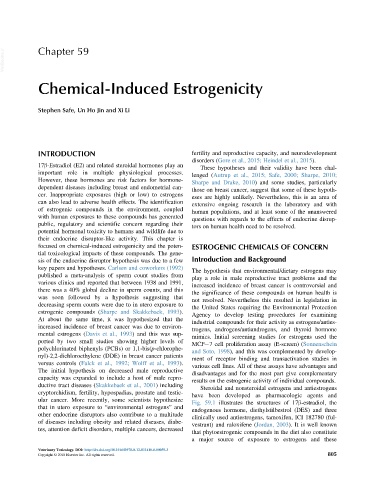Page 847 - Veterinary Toxicology, Basic and Clinical Principles, 3rd Edition
P. 847
VetBooks.ir Chapter 59
Chemical-Induced Estrogenicity
Stephen Safe, Un Ho Jin and Xi Li
INTRODUCTION fertility and reproductive capacity, and neurodevelopment
disorders (Gore et al., 2015; Heindel et al., 2015).
17β-Estradiol (E2) and related steroidal hormones play an
These hypotheses and their validity have been chal-
important role in multiple physiological processes.
lenged (Autrup et al., 2015; Safe, 2000; Sharpe, 2010;
However, these hormones are risk factors for hormone-
Sharpe and Drake, 2010) and some studies, particularly
dependent diseases including breast and endometrial can-
those on breast cancer, suggest that some of these hypoth-
cer. Inappropriate exposures (high or low) to estrogens
eses are highly unlikely. Nevertheless, this is an area of
can also lead to adverse health effects. The identification extensive ongoing research in the laboratory and with
of estrogenic compounds in the environment, coupled
human populations, and at least some of the unanswered
with human exposures to these compounds has generated
questions with regards to the effects of endocrine disrup-
public, regulatory and scientific concern regarding their
tors on human health need to be resolved.
potential hormonal toxicity to humans and wildlife due to
their endocrine disruptor-like activity. This chapter is
focused on chemical-induced estrogenicity and the poten- ESTROGENIC CHEMICALS OF CONCERN
tial toxicological impacts of these compounds. The gene-
sis of the endocrine disruptor hypothesis was due to a few Introduction and Background
key papers and hypotheses. Carlsen and coworkers (1992)
The hypothesis that environmental/dietary estrogens may
published a meta-analysis of sperm count studies from
play a role in male reproductive tract problems and the
various clinics and reported that between 1938 and 1991,
increased incidence of breast cancer is controversial and
there was a 40% global decline in sperm counts, and this
the significance of these compounds on human health is
was soon followed by a hypothesis suggesting that
not resolved. Nevertheless this resulted in legislation in
decreasing sperm counts were due to in utero exposure to
the United States requiring the Environmental Protection
estrogenic compounds (Sharpe and Skakkebaek, 1993).
Agency to develop testing procedures for examining
At about the same time, it was hypothesized that the
industrial compounds for their activity as estrogens/anties-
increased incidence of breast cancer was due to environ-
trogens, androgens/antiandrogens, and thyroid hormone
mental estrogens (Davis et al., 1993) and this was sup-
mimics. Initial screening studies for estrogens used the
ported by two small studies showing higher levels of
MCF 7 cell proliferation assay (E-screen) (Sonnenschein
polychlorinated biphenyls (PCBs) or 1,1-bis(p-chlorophe-
and Soto, 1998), and this was complemented by develop-
nyl)-2,2-dichloroethylene (DDE) in breast cancer patients
ment of receptor binding and transactivation studies in
versus controls (Falck et al., 1992; Wolff et al., 1993).
various cell lines. All of these assays have advantages and
The initial hypothesis on decreased male reproductive
disadvantages and for the most part give complementary
capacity was expanded to include a host of male repro-
results on the estrogenic activity of individual compounds.
ductive tract diseases (Skakkebaek et al., 2001) including
Steroidal and nonsteroidal estrogens and antiestrogens
cryptorchidism, fertility, hypospadias, prostate and testic-
have been developed as pharmacologic agents and
ular cancer. More recently, some scientists hypothesize
Fig. 59.1 illustrates the structures of 17β-estradiol, the
that in utero exposure to “environmental estrogens” and
endogenous hormone, diethylstilbestrol (DES) and three
other endocrine disruptors also contribute to a multitude
clinically used antiestrogens, tamoxifen, ICI 182780 (ful-
of diseases including obesity and related diseases, diabe-
vestrant) and raloxifene (Jordan, 2003). It is well known
tes, attention deficit disorders, multiple cancers, decreased
that phytoestrogenic compounds in the diet also constitute
a major source of exposure to estrogens and these
Veterinary Toxicology. DOI: http://dx.doi.org/10.1016/B978-0-12-811410-0.00059-3
Copyright © 2018 Elsevier Inc. All rights reserved. 805

